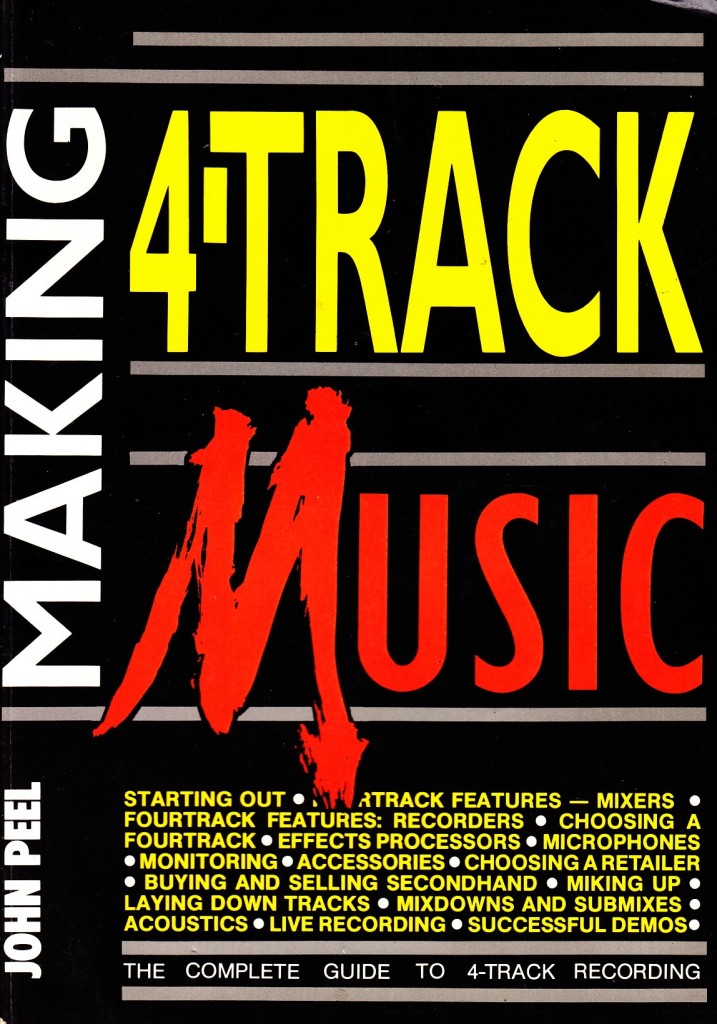 Download a seven-page scan of some interesting hardware on offer in “Making 4-Track Music,” Track Publishing 1987:
Download a seven-page scan of some interesting hardware on offer in “Making 4-Track Music,” Track Publishing 1987:
DOWNLOAD: 4trackMusic_JohnPeel
Includes advertisements for Yamaha MT2X, DX100, and RX17 drum machine; Akai MG614 four-track machine, Tascam Porta2 4-track, Fostex 160, the Boss Micro-Rack series (RDD-20 delay, RPS-10 pitch shifter, RCL-10 compressor, RRV-10 reverb, plus a ton more), and KORG’s multieffects.
*******
***
First-things-first: I have no idea if the ‘John Peel’ to whom this book is credited is the John Peel, he of legendary status as a DJ and taste-maker for an entire generation of rock and pop music. There is nothing whatsoever in this 98pp paperback volume (found in a Manchester OXFAM back in the early 00’s) that offers any indication pro or con. A third option would seem to be the ghostwriter scenario. Anyhow. “Making 4-Track Music” (h.f. “M4TM”) is an A5-sized paperback that attempts to introduce readers to the equipment and processes of using 4-track recorders.
The 4-track recorder, for those unfamiliar, is a category of product first introduced by the TASCAM corporation in 1979 with their model 144.
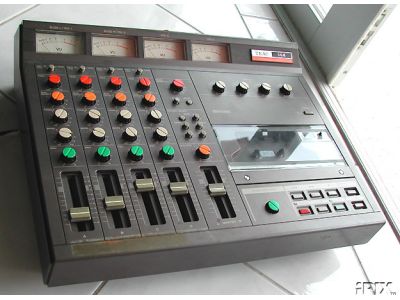 The 1979 TASCAM 144. Bruce Springsteen recorded his greatest album on this small plastic machine, believe-it-or-not. (Image source)
The 1979 TASCAM 144. Bruce Springsteen recorded his greatest album on this small plastic machine, believe-it-or-not. (Image source)
TASCAM already dominated the home-recording market with their 3440 1/4″ open reel tape recorder and the associated mixer-units that were marketed alongside it. These systems had a rather high cost of entry, though: they cost much more than a good used car. The 144 brought the basic concept of multi-track audio recording and mixing to a far lower price-point by using consumer cassette tape rather than 1/4″ open reel tape as the recording media, and by combining the audio-recording device and the audio-mixing apparatus into one single item. This made for a much more affordable system and it also made for easier use: no wires to hook up, no redundant or unnecessary features. Just the basic technology needed to record a performance and then add 3 additional performances in perfect synchronization while retaining the ability to control relative volumes and treatments of each track. With a creative user, the 4-track machine is capable of much more, but this is the basic concept.
“M4TM” covers all of this, and more; there is an explanation of the various recording and mixing features that the consumer would encounter in the marketplace, plus good treatment of the various types of additional processing equipment that a 4-track owner might like: digital time-based effects (delay, etc), compressors, gates, EQs., etc.
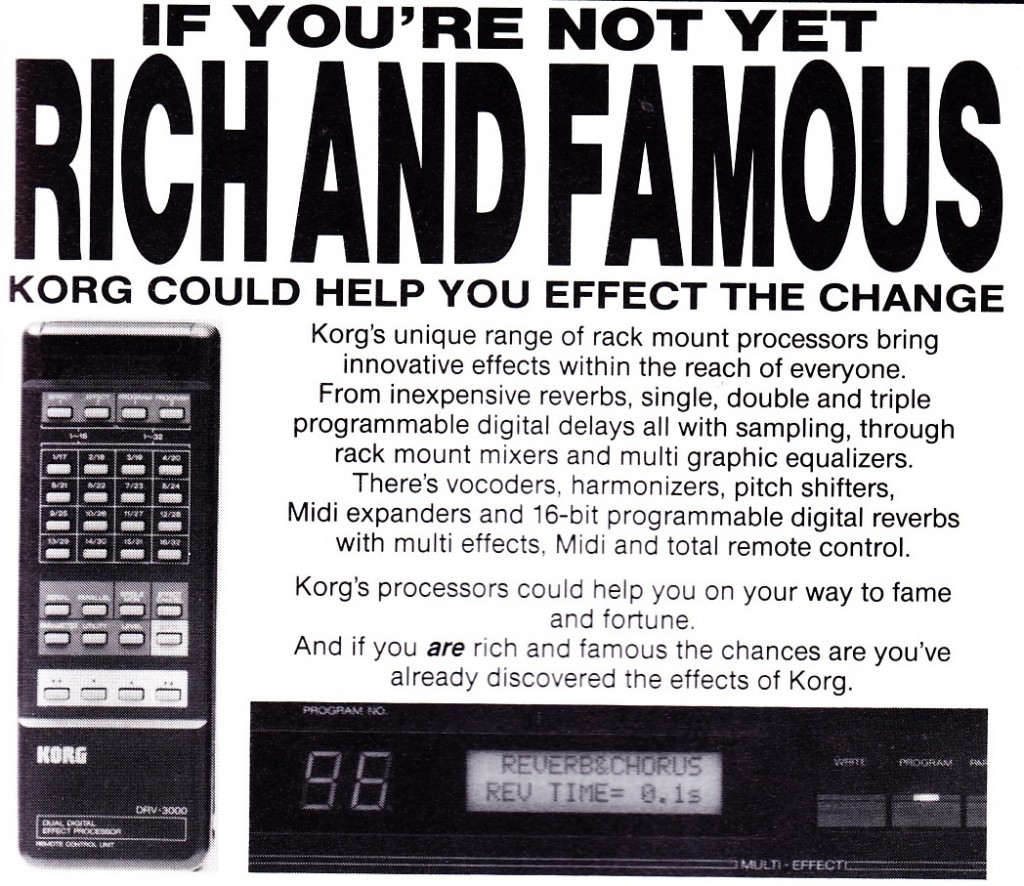 The aesthetics/art of making recordings is not really considered at all; there is a lot of talk about money, costs, (e.g., KORG’s above-depicted rainmaking) and the improved ‘recording quality’ that such expenditures can deliver but no mention of improving the presentation of songs and sonic ideas via any of this technology. Here’s a typical passage:
The aesthetics/art of making recordings is not really considered at all; there is a lot of talk about money, costs, (e.g., KORG’s above-depicted rainmaking) and the improved ‘recording quality’ that such expenditures can deliver but no mention of improving the presentation of songs and sonic ideas via any of this technology. Here’s a typical passage:
As someone who’s work is largely based on the commercial recording studio that I own and operate, I find it rather… alarming/offensive that the prime benefit of making a recording in a pro studio is the sound-quality, to extent that this benefit could be completely undone by several generations of tape-duplication. Jesus. I like to hope that I give my clients something more than a good signal-noise ratio and even frequency response. The passage above kind of makes it seem like it’s the EQUIPMENT in a studio that is doing the work, rather than the engineer… is this how most musicians feel about studios? Is this how I used to feel about studios, when I was 4-tracking at home at age 19?
(me at home, age 19: via Tascam Porta 03, Boss Micro -Rack effects): 07 The End
Furthermore, M4TM does not even entertain the aesthetic or artistic possibilities of all of this ‘4-track’ equipment. Rather, the emphasis is very much on ‘making-a-demo’ en route to possibly getting a ‘record deal,’ and all that this will entail (presumably the “Riches and Fame” for which you will have KORG to thank). The idea of possibly creating a compelling piece of artwork with this equipment is simply absent.
I wonder when this changed. By the time I started recording heavily on a four 4-track machine, a mere 8 years later (1995), musicians like Bill Callahan (aka SMOG) and Jeff Mangum (aka Neutral Milk Hotel) were already getting attention specifically as masters of 4-track recording. These guys did not appear too interested in making a ‘real record’ in a ‘pro studio.’ The 4-track medium, with its attendant tape hiss, awkward usage once you went past four tracks, and total absence of any sort of editing ability, was a huge part of the artwork that they created. Artwork that has truly endured.
I went to see Jeff Mangum perform last week here in CT. He did a solo set at the Shubert Theatre in New Haven. Jeff Mangum has not released a major album of his own in 13 years. The Shubert was nearly sold-out to it’s 1591 capacity.
Have a listen (above) to “Naomi” from Neutral Milk Hotel’s 1996 4-track masterpiece “On Avery Island.” Would these songs have been rendered any more compelling had they been tracked and mixed in a studio? I think we all know the answer to that… Ultimately, though, what Mangum’s solo-acoustic-gtr-and-voice performance at the Shubert last week demonstrated to me was more the fact that it probably honestly didn’t matter how he had made those seminal recordings: the songs themselves are so good and his voice and affect are so well-wrought that their properties can impress regardless of the presentation.
Perhaps I am reading into this all too much…perhaps my ideas and taste are a bit ‘off’ and therefore I have ‘niche’ values. Mangum seems, to me, to be a very straightforward singer/songwriter.. but perhaps my appreciation for artists like Jeff Mangum simply indicates that I have ‘weird’ taste, that I am out-of-step with ‘mainstream’ values… Goggle seems to think so. Here’s what you will see if you play a Neutral Milk Hotel song on Youtube:
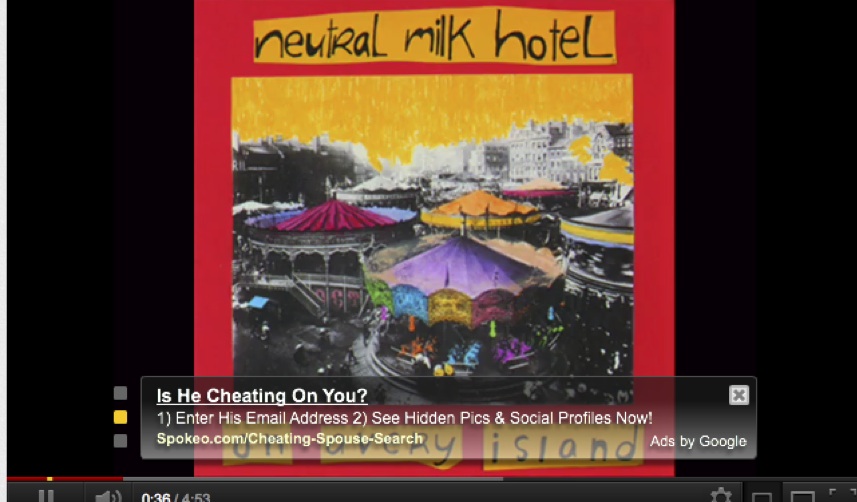
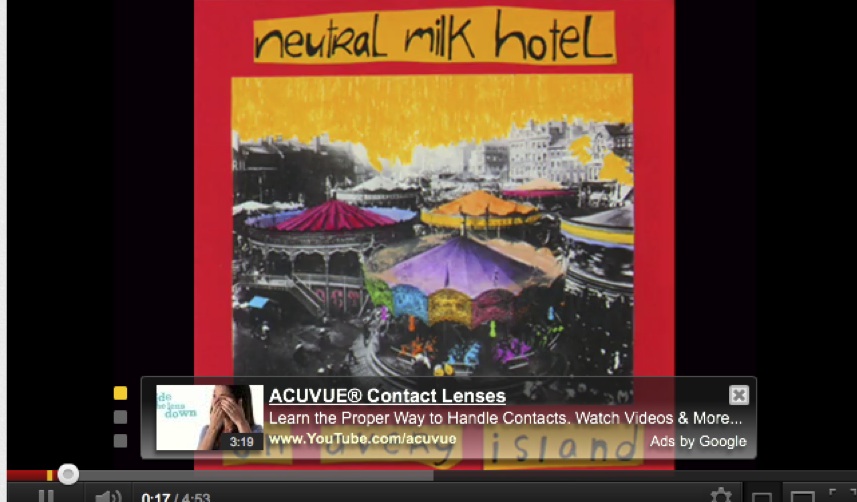
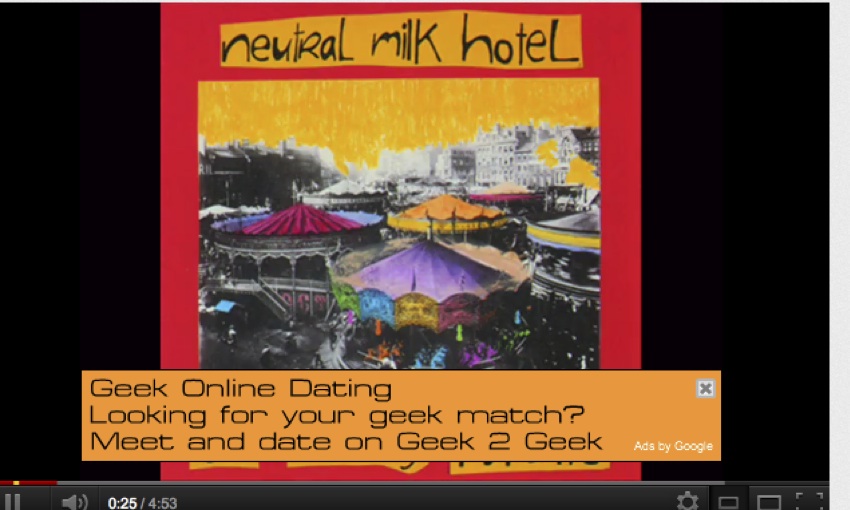
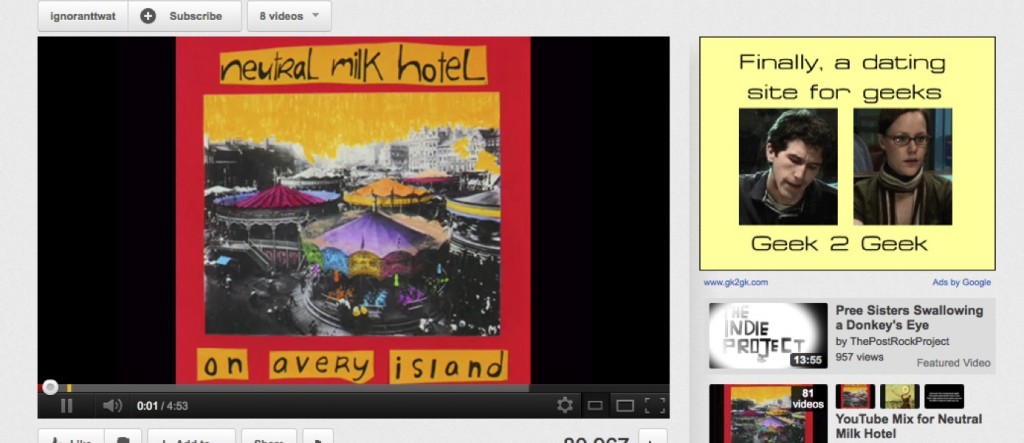
 Is your significant-other cheating on you? Maybe you need to lose those glasses: improve yr appeal? Fuck it, man, you’re a GEEK. Face it. Geek geek geek. Date another geek.
Is your significant-other cheating on you? Maybe you need to lose those glasses: improve yr appeal? Fuck it, man, you’re a GEEK. Face it. Geek geek geek. Date another geek.
I am so confused.
1987/2012: Maybe our John Peel simply wrote “M4TM” in a lost era, simple as that… an era when there still was a vigorous economic basis for the music-recording-industry and therefore the idea of recording music as INDUSTRY rather than EXPLOIT was still the dominant theme. It’s also interesting to consider that around the time of the first Neutral Milk Hotel album we also saw the introduction of Tape Op magazine, the first (that I am aware of…) widely-distributed publication that embraced the ethos of home-recording as a serious art form. And all of this happened just-in-time for the introduction of the first affordable DAWs (e.g., Pro Tools LE), which completely changed both the technique and the aesthetics of audio recording forever. You still need to be able to write a good song though. That much hasn’t changed.
Previous 4-track coverage on PS dot com:
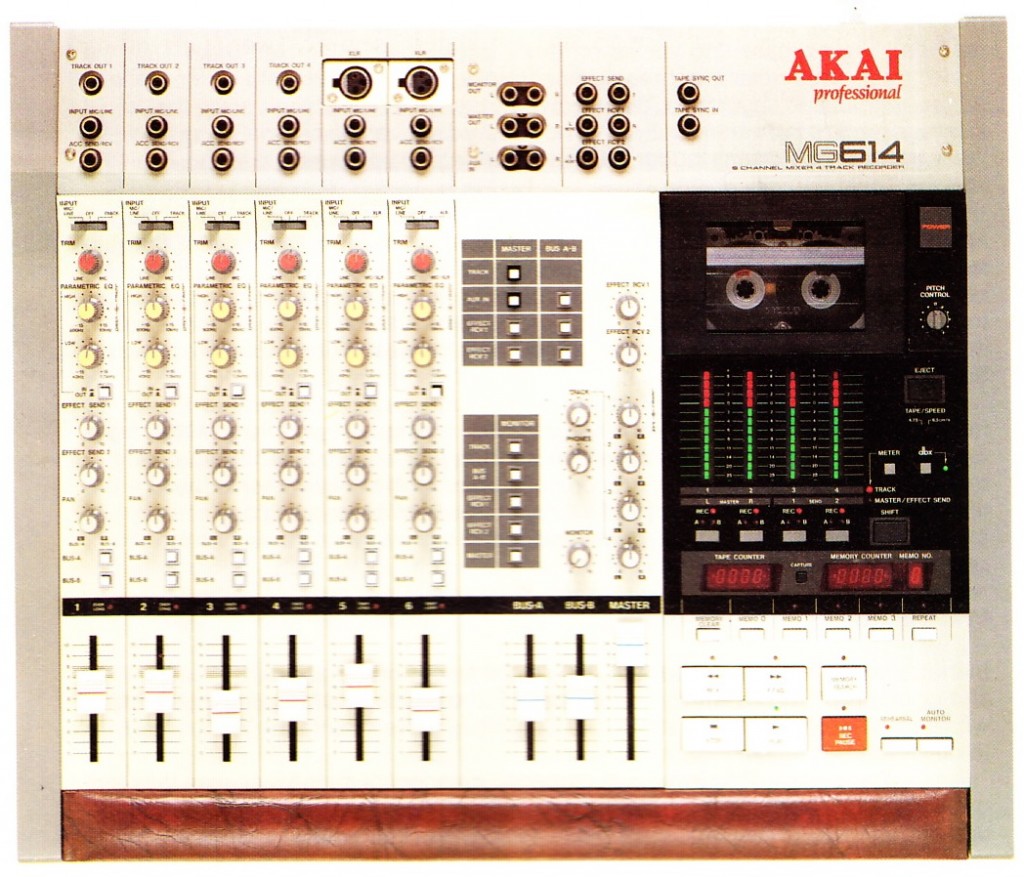
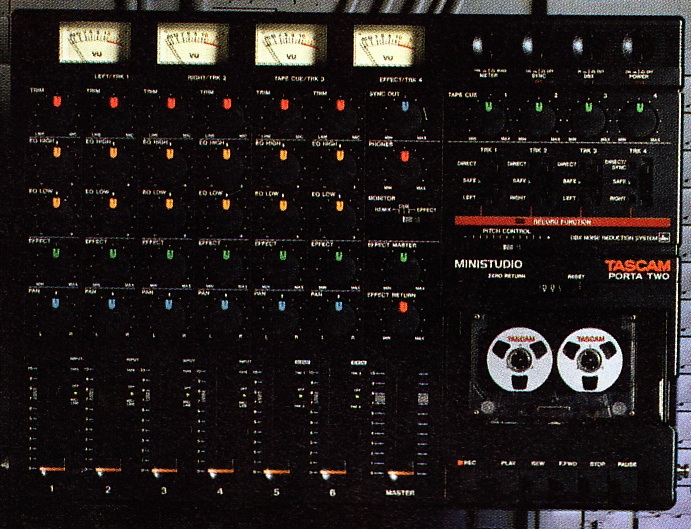

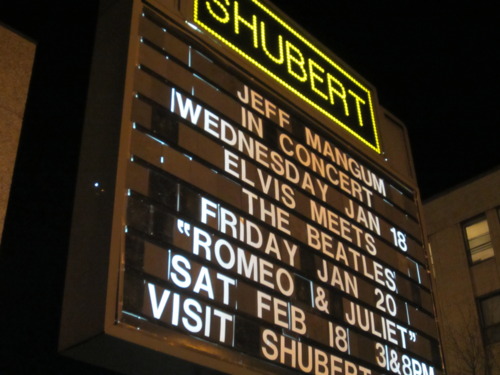
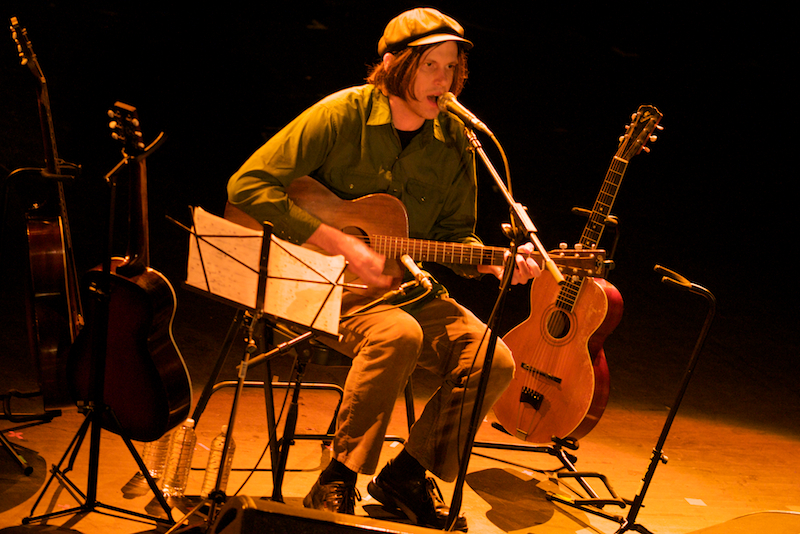
12 replies on “Out-of-print Book Report: “Making 4-Track Music,” John Peel (TRACK pub., 1987)”
If I remember how I thought back then….the idea was to become a Rock Star and have a Major Label Deal that paid Money…lots and lots of Money….which is why you didn’t go to/dropped out of school or turned down a union (construction/autoworker/etc) card or Dodged The Draft….depending on your parents’ economic stratum and academic inclinations (and the exact time frame). It wasn’t about a hobby or even Art. No matter how you view that dream today, a lot of young people walked away from a lot of things to pursue it. My best friend in high school turned down a full ride scholarship to an Ivy to do the rock-and-roll thing. He wound up going back to school at 35 and shakes his head at what could have been.
This stuff was a stepping stone pure and simple, a machine to make a resume with. Or, that’ s how it was marketed and how most people took it. After Springsteen’s Nebraska, that changed a little, but before this kind of stuff got any good, the Pro Tools stuff came in. Regular DAT was never big in the US, and Alesis ADAT was around for a few years, but it was klutzy.
I was the publisher of Making 4-Track Music and Making Multi-Track Music, in the 80s. John Peel (not the DJ) was a contributor to my magazine Making Music. The book was an early attempt to help de-mystify the then new electonification of music.
I think a fair number were sold to school language labs and churches bought some too. I worked on a lot of cassette duplicators for (usually) fundie churches who would put out cassettes of their message at truck stops, flea markets and the rest. They were big cash generators because people would take them home, listen to the blurb about contributing at the end and people would. They would record the preacher on one track, the organ on another, etc. and mix down to the dupe machine. That way they could have one intro for the preacher and a standard organ or praise band track and use it for several sermons. Or the same sermon with organ on one distribution and praise band on the other. Whatever.
A female comic years ago joked that a pair of these preachers, the Peters Brothers, condemned the Doobie Brothers because a “doobie” was, as we all know, a marijuana cigarette. “But you’re the PETERS Brothers!” was her reply. Yeah, I knew ’em, and dozens of others. The regular fundies were boring and dull, but you’d get these really tripping people sometimes. We had an old lady that maintained she was half space alien and gave rambling talks on the Bible, the Book of Enoch, and old Sanskrit texts. It turned out that she had worked on the earliest digital computers after WWII and knew a great deal of basic computer science. However, she refused to use modern personal computers because there were no lights to watch the individual data and address registers. She had a LOT of tapes made and when she died cases upon cases of them were in her apartment. All were dumpstered: I wish I’d kept one or two of them.
A bit late, but the mystery is solved – I worked on a few of these books (there was a whole series, including MIDI, setting up guitars, bass guitar, synthesisers, er…). They were a spin-off from a rather fine UK magazine called Making Music, itself the offspring of musicians’ mag One Two Testing. Alumni include Tony Bacon, current author of countless top-selling guitar nerds’ bedside books.
To be fair, like every similar publication of that era they had no inkling of the massive tech changes that were going to happen shortly – at that stage ‘a mere 8 years later’ equates to about three millennia in musical gear evolution terms.
And the early Portastudios and Fostexes were deeply crap, compared to the later versions – I remember pitch wobble and unreliable punch-ins and -outs being a particular issue. Eight years later, it was still lo-fi but at least you could stay roughly in tune with yourself for more than 30 seconds.
Still, I’m glad some of these books have survived. And no, it wasn’t that John Peel…
thanks for writing in Chris! tell us about your current ventures. Still in journalism/music?
Hi…for information..
The author of this book would always confirm he was the ‘real’ John Peel, when asked, as the DJ changed his name to John Peel. There was an interview… John Peel talks to John Peel.. I don’t think they particularly liked each other.. and both have moved on to other things..
Really like your musical piece posted here, Chris!
Something about the sound quality just makes it all the better, too.
(:
Cheers,
Ev.
haha thanks man. Yeah ya know what that was the first time that I ever felt I had accomplished something sonically (as opposed to strictly musically). So, the beginning of the end so-to-speak. No pun intended.
thanks for writing in Chris! tell us about your current ventures. Still in journalism/music?
I always believed this was written by Peely himself, what a let down, I always attribute my success (or lackof to be honest) to what I read in this book. This was a great book and there was really nothing like this back in the day, theres still nothing like this because 4 track recording is a lost art, bands nowadays don’t know how easy they’ve got it.
Making Music was another pre-internet look into a world that was otherwise completely unobtainable. I remember it being a free magazine, I picked it up regularly when i was about 10-12 years old, the music shop didnt appreciate me not buying anything to go with my free copy though.
Thats a different cover to my copy, I think there must have been a few editions.
Thanks for your kind comments on Making Music magazine. I started this magazine in 1986 and took on the editorial team from the about-to-go-bust 1,2 Testing: Paul Colbert, later to become editor of NME, Tony Bacon, prolific historian and expert on guitars, and John Lewin, who in 1992 moved to BBC radio to produce the Danny Baker show.
The idea was to make music more accessible to young (and not so young) musicians and to try to interpret the burgeoning complexities of making music emerging at that time: ‘music is fun, not science’ was the clarion call. MM was iconoclastic in the way it presented features on making it in the business, dealing with subjects like touring in a Transit with four farting musicians, and dealing with the lead singer’s partner who wants to join the band (think Paul and Linda). It was also unique among its peers in testing instruments and equipment, warts and all, which frequently incurred the wrath of the biggest names in the industry. It’s 60,000 circulation, distributed free through music instrument outlets was by far the biggest of any musician’s magazine and made it a strong force in the business. Its annual ‘best instruments awards’, presented by luminaries such as Jools Holland, George Martin and Mark King at a glittering ceremony at the prestigious MusicMesse in Frankfurt, was much coveted by the industry.
I sold the magazine at its height in 1994. Unfortunately, the new owners had no empathy with the ethos of the magazine so it quickly shrank in size and reputation and within a very few years it closed.
I was the founder and publisher of Making Music which published Making 4-Track Music, superseded by Making Multi-Track Music. It was part of our mission to de-mystify the increasing electronifiction of music in the 80s. The late DJ John Peel had nothing to do with it; author John Peel was the magazine’s wizard contributor on all things electronic.